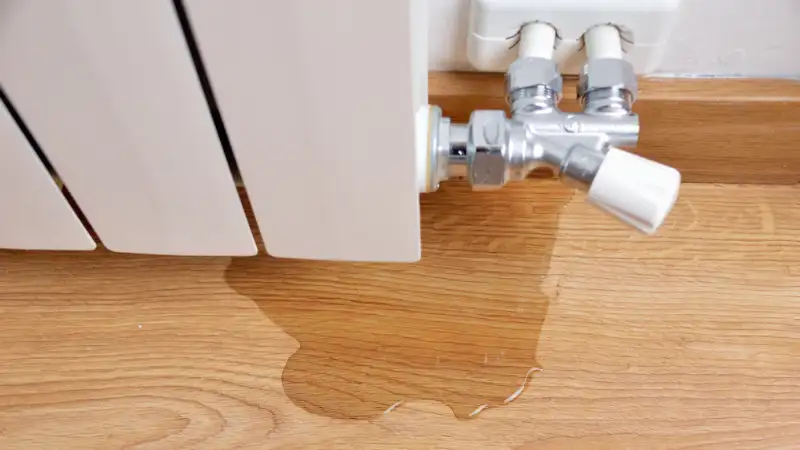This article will guide you through the common causes, symptoms, fixes, and prevention methods for leaky radiator valves.
What Causes Leaky Radiator Valves?
Understanding the root causes of a leaky radiator valve can help you quickly identify and resolve the issue. Here are some of the most common reasons for a leak:
- Wear and Tear: Over time, radiator valves are subject to regular use and aging. This can cause the valve to loosen and eventually leak, especially if it’s an older system.
- Corrosion: The exposure of radiator valves to water can lead to corrosion. When the metal components of the valve start to corrode, they weaken, making leaks more likely.
- Loose Fittings: If the valve hasn’t been tightly fitted, small gaps can form, allowing water to seep out.
- High Water Pressure: Systems with higher water pressure can put extra strain on the radiator valves. The constant pressure could damage the valve’s internal mechanisms and cause it to leak.
- Faulty Washers: Washers inside the valve create the necessary seal to prevent leaks. If these washers deteriorate or wear out, water will seep through.
How to Detect a Leaky Radiator Valve
It’s essential to know the signs of a leaky radiator valve so you can act quickly before the problem worsens. Some telltale signs include:
- Water around the radiator: Pooling water near the radiator base is the most visible sign of a leaky valve.
- Damp floors or walls: Persistent leaks can cause damp patches on nearby surfaces like carpets, wooden floors, or walls.
- Hissing or dripping sounds: If you hear a hissing noise when your heating is on or a consistent drip, it could be an indication of a slow leak.
- Decreased heating performance: Leaky valves can reduce the amount of water circulating through your system, leading to uneven heating and colder spots in your home.
How to Fix a Leaky Radiator Valve
Once you’ve identified a leaky valve, the next step is to fix it. While some repairs are simple enough for DIY enthusiasts, others may require the expertise of a plumber. Here’s a step-by-step guide on how to fix a leaky radiator valve:
1. Turn Off the Heating System
Before attempting any repair, always turn off your heating system. This will prevent hot water from flowing through the radiator and protect you from potential burns.
2. Identify the Leak Source
Examine the valve carefully to locate the exact source of the leak. The leak could come from the valve stem, the connection between the valve and the pipe, or the radiator itself.
3. Tighten the Valve
If the leak is around the joint or fitting, use a spanner to gently tighten the valve. Be careful not to over-tighten, as this could damage the valve or pipes.
4. Replace the Washer
If tightening the valve doesn’t work, the internal washer may need replacement. To do this:
- Turn off the water supply.
- Drain the radiator by turning off the valve at both ends and opening the air vent.
- Remove the valve and replace the old washer with a new one.
- Reassemble the valve and turn the water supply back on.
5. Use PTFE Tape
If the leak is coming from the thread connection, wrap PTFE tape around the valve thread before screwing it back in place. This will help create a tighter seal and prevent further leaks.
6. Call a Professional
If you’re unsure about tackling the issue yourself or if the leak persists despite your efforts, it’s best to contact a professional plumber. They will have the necessary tools and expertise to repair or replace the faulty valve.
Preventing Future Leaky Radiator Valves
Preventative maintenance is key to avoiding future leaks and ensuring that your heating system remains efficient. Here are some tips to help you prevent leaky radiator valves:
1. Regular Maintenance
Schedule an annual inspection of your heating system to catch potential issues before they become significant. A professional can check the condition of your radiator valves, replace any worn parts, and perform general maintenance on the system.
2. Monitor Water Pressure
High water pressure can put unnecessary strain on radiator valves. Keep an eye on your system’s pressure gauge, and if it’s consistently high, you may need to adjust it to the recommended range. Most systems should have a pressure between 1.5 and 2 bars when the heating is on.
3. Use Corrosion Inhibitors
Corrosion is a leading cause of valve leaks. Adding a corrosion inhibitor to your heating system’s water can help slow down the build-up of rust and other corrosive materials, keeping your valves in better condition.
4. Replace Old Valves
If your home has an older heating system, consider upgrading the radiator valves. Newer models are designed to be more durable and energy-efficient, reducing the chances of leaks.
5. Check Valve Tightness
Periodically check the tightness of your radiator valves, especially after any repairs or maintenance. Ensuring the valves are properly secured can help prevent small leaks from turning into bigger problems.
When to Call a Professional
While many radiator valve leaks can be fixed with basic tools and a bit of DIY knowledge, there are times when it’s better to call in a licensed plumber. Consider professional help if:
- The leak persists despite your attempts to fix it.
- The valve or radiator shows signs of extensive corrosion.
- You’re dealing with multiple leaks across different parts of your heating system.
A professional can also advise on the overall condition of your heating system and suggest long-term solutions to prevent recurring leaks.
Conclusion
Leaky radiator valves are a common issue in homes, but they don’t have to be a major headache. With regular maintenance, a basic understanding of how to fix leaks, and proactive measures to prevent future issues, you can keep your heating system running smoothly and efficiently. Ignoring a leak, however, can lead to increased heating bills, potential water damage, and a less comfortable living environment. Don’t let a small leak turn into a big problem address it as soon as possible for peace of mind and long-term savings.

